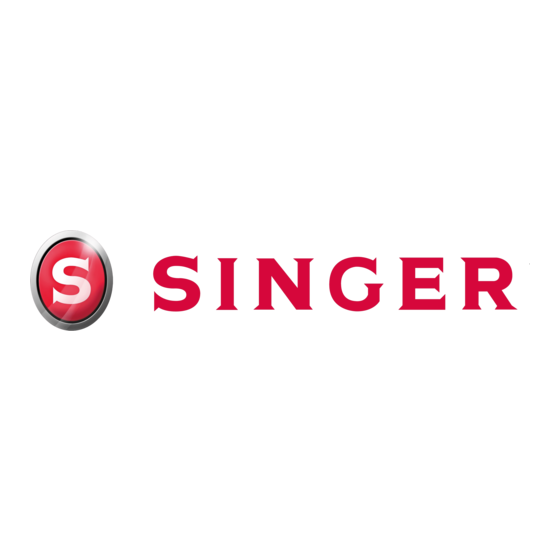
Table of Contents
Advertisement
Advertisement
Table of Contents

Subscribe to Our Youtube Channel
Summary of Contents for Singer 1640
- Page 1 INSTRUCTION MANUAL SEWING MACHINE MODEL 1640 FREE-ARM...
-
Page 2: Table Of Contents
INDEX Section 1. FEATU RES AND PARTS Front View Rear View Convert ible Extensio n Plate Attachin g Extensio n Plate Electrica l Equipme nt Sewing Light Accesso ries Section 2. BASIC INFORM ATION Needle. Thread and Fabric Chart Changin g Presser Foot Changin g Needle Removin g Needle Plate Removin g Bobbin Case... -
Page 4: Front View
Section 1 FEATURES AND PARTS FRONT VIEW Hook Cover Face Plate Thread Tension Dial Thread TakeUp Lever Tension Check Spring Pattern Panel Stitch Selector Dial Thread Guide (G) Stitch Width Dial Needle Bar Thread Guide Presser Foot Thumb Screw Stitch Length Dial & Reverse Presser Foot Push Button Handle On Top Cover... -
Page 5: Rear View
—... -
Page 6: Convertible Extension Plate
Section CONVERTIBLE EXTENSION PLATE The built-in, snap-up extension plate quickly converts the sewing platform from free arm to flatbed. Attach ing the Extension Plate For ordinary sewing, the extension plate will make your work easier. Carefully place the extension plate on the free arm, levelling the plate with the free arm, inserting pins on plate into corresponding holes on base of arm. -
Page 7: Electrical Equipment
Section 1 ELECTRICAL EQUIPMENT Plug foot pedal cord into your wall outlet, and connector to terminal box on machine as shown in Fig. 2A CAUTION: When in use, please be sure to disconnect the cord plug from electrical outlet. SEWING LIGHT Sewing light is located directly over the needle so as to better illuminate stitching Turn sew light switch on and off... -
Page 8: Accesso Ries
Section 1 ACCESSORI ES E WWc IACHINE iffPLES Button Sewing Foot Plastic Oiler (sealed and filled) Buttonhole Foot (on machine) Package of Needles (5 straight Zipper Foot needles and 1 twin needle) Felt Washers (2) for spool pins Large Screw Driver Bobbins (3) Small Screw Driver Zigzag Foot (on machine) -
Page 9: Needle. Thread And Fabric Chart
NEEDLE, THREAD AND FABRIC CHART fabric you are stitching. The needle and thread you choose depends upon the fibers of light weight The correct needle size is important to avoid damaging the breakage when stitching heavy or or tightly woven fabrics and to prevent needle stiff fabrics. -
Page 10: Changing Presser Foot
Section 2 CHANGING PRESSER FOOT Raise needle to its highest position by turning hand wheel toward you. Raise presser foot by lifting Presser Foot Lifter located on back of machine. screw remove thumb Loosen foot. Place grooved side of selected presser foot against presser bar. - Page 14 Pass (B> Dial (C) (G> view — — view H— :— F1g8...
-
Page 16: Re-Winding Bobbin When Machine Is Threaded
SECTION 3 RE-WINDING BOBBIN WHEN MACHINE IS THREADED If bobbin runs out of thread while sewing, it is not necessary to completely unthread machine to re-wind bobbin. Simply bring thread from needle up through top thread guide in front of machine (Fig. Insert end of thread from inside to outside in one of the holes of empty boddin. -
Page 17: Checkin G Tension Of Upper Thread
TENSION OF UPPER THREAD An important point when sewing is to make sure that the thread tension The Thread Tension Dial is correct. Correct Stitch is marked with 0 to 9. Normal thread tension is obtained by setting the Dial Your at 5 against the top hook. - Page 18 — — — — —...
-
Page 22: Stitch Length
Section 5 STITCH ING TIPS • Check that dials are set correctly for the stitch you want stitch pattern, — stitch length, and stitch width. Needle should be straight, • Use proper needle and thread for your fabric. sharp and inserted properly. Change your needle frequently. •... - Page 23 zigzag, Dial (B Fig. will be will Dial —20—...
- Page 27 ““ “, “...
- Page 29 Seion 6 SEWING ON BUTTONS You can sew both two and four holes of buttons with your machine. Change presser foot to the button sewing foot (Fig. 39) and lower drop feed by placing feed cover on needle plate (See Page 1 7).
- Page 32 — — —...
- Page 33 — — —...







Need help?
Do you have a question about the 1640 and is the answer not in the manual?
Questions and answers
What year were these made